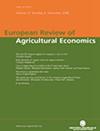一切尽在掌握:利用 FADN 数据比较机器学习和传统计量经济学影响评估方法
IF 3.5
2区 经济学
Q2 AGRICULTURAL ECONOMICS & POLICY
引用次数: 0
摘要
已经提出了机器学习(ML)方法,通过增强因果推理来改进农业政策的评估。本研究使用为农场会计数据网络(FADN)数据量身定制的模拟框架,仔细检查ML和经典方法在各种因果属性下的性能,这些属性对于识别至关重要。我们的研究结果显示,在不同的处理分配规则、样本量和因果性质中,绩效存在显著差异。值得注意的是,因果森林方法在检索因果效应和准确表征其异质性方面始终优于其他方法。然而,ML方法的数据驱动方法在选择正确的控制集和处理潜在混淆方面被证明是无效的。本文章由计算机程序翻译,如有差异,请以英文原文为准。
Everything under control: comparing machine learning and classical econometric impact assessment methods using FADN data
Machine learning (ML) methods have been proposed to improve the assessment of agricultural policies through enhanced causal inference. This study uses a simulation framework tailored to Farm Accountancy Data Network (FADN) data to scrutinize the performance of both ML and classical methods under diverse causal properties crucial for identification. Our findings reveal significant variations in performance across different treatment assignment rules, sample sizes and causal properties. Notably, the Causal Forest method consistently outperforms others in retrieving the causal effect and accurately characterizing its heterogeneity. However, the data-driven approach of ML methods proves ineffective in selecting the correct set of controls and addressing latent confounding.
求助全文
通过发布文献求助,成功后即可免费获取论文全文。
去求助
来源期刊

European Review of Agricultural Economics
管理科学-农业经济与政策
CiteScore
6.60
自引率
5.90%
发文量
25
审稿时长
>24 weeks
期刊介绍:
The European Review of Agricultural Economics serves as a forum for innovative theoretical and applied agricultural economics research.
The ERAE strives for balanced coverage of economic issues within the broad subject matter of agricultural and food production, consumption and trade, rural development, and resource use and conservation. Topics of specific interest include multiple roles of agriculture; trade and development; industrial organisation of the food sector; institutional dynamics; consumer behaviour; sustainable resource use; bioenergy; agricultural, agri-environmental and rural policy; specific European issues.
Methodological articles are welcome. All published papers are at least double peer reviewed and must show originality and innovation. The ERAE also publishes book reviews.
 求助内容:
求助内容: 应助结果提醒方式:
应助结果提醒方式:


